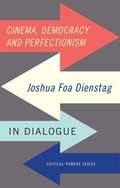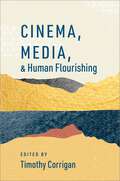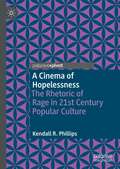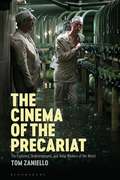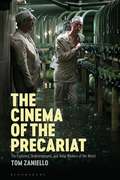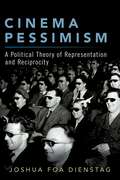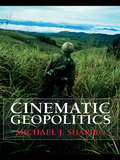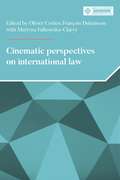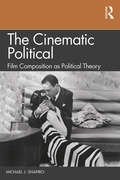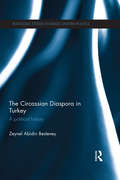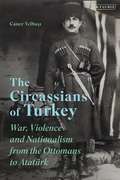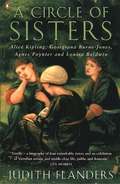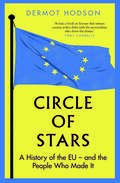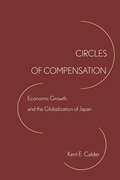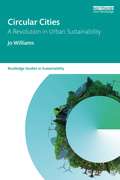- Table View
- List View
Cinema, democracy and perfectionism: Joshua Foa Dienstag in dialogue
by Joshua Foa DienstagJoshua Foa Dienstag engages in a critical encounter with the work of Stanley Cavell on cinema, focusing skeptical attention on the claims made for the contribution of cinema to the ethical character of democratic life.
Cinema, democracy and perfectionism: Joshua Foa Dienstag in dialogue (PDF)
by Joshua Foa DienstagJoshua Foa Dienstag engages in a critical encounter with the work of Stanley Cavell on cinema, focusing skeptical attention on the claims made for the contribution of cinema to the ethical character of democratic life.
Cinema, Law, and the State in Asia
by C. Creekmur M. SidelThis book explores the intersections of film, justice, and the state in comparative perspective across a range of major Asian countries, including India, China, Japan, Korea, the Philippines, and Vietnam. The contributing authors cross the conventional border between the analysis of on-screen and off-screen intersections of law and cinema.
Cinema, Media, and Human Flourishing (The Humanities and Human Flourishing)
by Timothy CorriganThe Humanities and Human Flourishing series publishes edited volumes that explore the role of human flourishing in the central disciplines of the humanities, and whether and how the humanities can increase human happiness. This edited volume examines the role of cinema and media in the context of human flourishing. The history of cinema is rife with films and genres in which positive cinematic narratives stand out as remarkable and defining achievements. Since the 1930s through the superhero movies of today, from You Can't Take It with You or Toy Story to literary adaptations like Midsummer Night's Dream or Clueless, films have celebrated the resilience and triumphs of people pursuing a life of happiness and contentment. Yet, in the majority of these films, various crises shadow these pursuits, adding obstacles and detours that suggest films require a narrative drama of conflict, out of which human well-being and flourishing eventually emerge. This volume covers a multitude of historical periods and topics, including discussions of the Aristotelian and classical models of a "good life" that inform animated fairy tales today; how 1930s French and Hollywood films responded to the dire need for productive human relationships in a turbulent decade; the polemical positions of black film criticism through the lens of James Baldwin; a discussion of contemporary filmic quests for happiness; the challenges for women filmmakers today in mapping the values of their own world; the scientific, psychological, and philosophical base for human value; and the shifting media frames of modern society and selves. Cinema, Media Studies, and Human Flourishing features a diverse array of approaches to understanding human flourishing through cinematic representations of the journey to a fulfilling life.
Cinema, Media, and Human Flourishing (The Humanities and Human Flourishing)
by Timothy CorriganThe Humanities and Human Flourishing series publishes edited volumes that explore the role of human flourishing in the central disciplines of the humanities, and whether and how the humanities can increase human happiness. This edited volume examines the role of cinema and media in the context of human flourishing. The history of cinema is rife with films and genres in which positive cinematic narratives stand out as remarkable and defining achievements. Since the 1930s through the superhero movies of today, from You Can't Take It with You or Toy Story to literary adaptations like Midsummer Night's Dream or Clueless, films have celebrated the resilience and triumphs of people pursuing a life of happiness and contentment. Yet, in the majority of these films, various crises shadow these pursuits, adding obstacles and detours that suggest films require a narrative drama of conflict, out of which human well-being and flourishing eventually emerge. This volume covers a multitude of historical periods and topics, including discussions of the Aristotelian and classical models of a "good life" that inform animated fairy tales today; how 1930s French and Hollywood films responded to the dire need for productive human relationships in a turbulent decade; the polemical positions of black film criticism through the lens of James Baldwin; a discussion of contemporary filmic quests for happiness; the challenges for women filmmakers today in mapping the values of their own world; the scientific, psychological, and philosophical base for human value; and the shifting media frames of modern society and selves. Cinema, Media Studies, and Human Flourishing features a diverse array of approaches to understanding human flourishing through cinematic representations of the journey to a fulfilling life.
A Cinema of Hopelessness: The Rhetoric of Rage in 21st Century Popular Culture (Rhetoric, Politics and Society)
by Kendall R. PhillipsThis book explores the circulation of anger and hostility in contemporary American culture with particular attention to the fantasy of refusal, a dream of rejecting all the structures of the contemporary political and economic system. Framing the question of public sentiment through the lens of rhetorical studies, this book traces the circulation of symbols that craft public feelings in contemporary popular cinema. Analyzing popular twenty-first century films as invitations to a particular way of feeling, the book delves into the way popular sentiments are circulated and intensified. The book examines dystopian films (The Purge, The Cabin in the Woods), science fiction (Snowpiercer), and superhero narratives (the Marvel Cinematic Universe and Joker). Across these varied films, an affective economy that emphasizes grief, betrayal, refusal, and an underlying rage at the seeming hopelessness of contemporary culture is uncovered. These examinations are framed in terms of ongoing political protests ranging from Occupy Wall Street, the Tea Party, Black Lives Matter, and the 6th January 2021 invasion of the US Capitol Building.
The Cinema of the Precariat: The Exploited, Underemployed, and Temp Workers of the World
by Thomas ZanielloThe Cinema of the Precariat is the first book to lay out the incredible range of the precariat (the social class suffering from precarity) as well as a detailed report on the cinematic record of their work and lives.It discusses a thorough and definitive selection of more than 250 films and related visual media that take the measure of the precariat worldwide. For example, thousands of Haitians, including children, harvest sugar cane in the Dominican Republic (The Price of Sugar), while illegal Afghan refugees work in Iran (Delbaran). More familiar are the millions of Latino immigrants, legal or not, of all ages, that work in the United States (Food Chains). Each chapter focuses on a sub-class of the precariat or a contested zone of labor or the evolving political manifestation of the struggles of the unorganized and the dispossessed. Among the hundreds of bewildering film choices available nowadays this book offers the reader reliable guidance to the films bringing to life the economic, political, and social dilemmas faced by millions of the world's global workforce and their families.
The Cinema of the Precariat: The Exploited, Underemployed, and Temp Workers of the World
by Thomas ZanielloThe Cinema of the Precariat is the first book to lay out the incredible range of the precariat (the social class suffering from precarity) as well as a detailed report on the cinematic record of their work and lives.It discusses a thorough and definitive selection of more than 250 films and related visual media that take the measure of the precariat worldwide. For example, thousands of Haitians, including children, harvest sugar cane in the Dominican Republic (The Price of Sugar), while illegal Afghan refugees work in Iran (Delbaran). More familiar are the millions of Latino immigrants, legal or not, of all ages, that work in the United States (Food Chains). Each chapter focuses on a sub-class of the precariat or a contested zone of labor or the evolving political manifestation of the struggles of the unorganized and the dispossessed. Among the hundreds of bewildering film choices available nowadays this book offers the reader reliable guidance to the films bringing to life the economic, political, and social dilemmas faced by millions of the world's global workforce and their families.
Cinema Pessimism: A Political Theory of Representation and Reciprocity
by Joshua Foa DienstagAesthetic and political representation are often treated separately, but this book argues that film offers a unique perspective through which to understand the dangers to equality and freedom that lurk in representative politics. The potential problems of representative democracy have long been debated: does it cultivate apathy and discourage citizen participation? What does it mean to be faithfully or well represented in a democracy? And how can appropriate, meaningful representation be achieved? Here, these questions are addressed from a new perspective. Representation, Joshua Foa Dienstag argues, can create the illusion of freedom and reciprocity in place of the real thing, and in both cinema and politics, what gives us pleasure is not the same as what secures or supports our existence as free and equal citizens. As this book shows, there are political dangers not visible within the current debates around democratic representation, dangers we can better understand and help to minimize by considering the way that human beings interact, emotionally, with their filmic representations. Dienstag looks at a series of films that directly confront issues of representation (Her, Blade Runner, The Man Who Shot Liberty Valance, Melancholia, and the Up documentary series) to diagnose these hazards and consider how best to respond to them. Each chapter looks at a specific film as emblematic of a different conception or problem of representation often ignored by mainstream political debates (such as reciprocity, happiness, boundaries, evil) to show that the relationship between representation and freedom is fraught with tension. This book continues Dienstag's earlier groundbreaking work on philosophical pessimism, understood not as something despairing, but as a rejection of the idea that these necessary tensions can be cured. Ultimately, Dienstag seeks to defend a kind of pessimistic politics that might produce a better sort of democratic representation than what we have today.
Cinematic Geopolitics
by Michael J. ShapiroIn recent years, film has been one of the major genres within which the imaginaries involved in mapping the geopolitical world have been represented and reflected upon. In this book, one of America's foremost theorists of culture and politics treats those aspects of the "geopolitical aesthetic" that must be addressed in light of both the post cold war and post 9/11 world and contemporary film theory and philosophy. Beginning with an account of his experience as a juror at film festival’s, Michael J. Shapiro’s Cinematic Geopolitics analyzes the ways in which film festival space and both feature and documentary films function as counter-spaces to the contemporary "violent cartography" occasioned by governmental policy, especially the current "war on terror." Influenced by the cinema-philosophy relationship developed by Gilles Deleuze and the politics of aesthetics thinking of Jacques Ranciere, the book’s chapters examines a range of films from established classics like the Deer Hunter and the Battle of Algiers to contemporary films such as Dirty Pretty Things and the Fog of War. Shapiro’s use of philosophical and theoretical works makes this cutting edge examination of film and politics essential reading for all students and scholars with an interest in film and politics.
Cinematic Geopolitics
by Michael J. ShapiroIn recent years, film has been one of the major genres within which the imaginaries involved in mapping the geopolitical world have been represented and reflected upon. In this book, one of America's foremost theorists of culture and politics treats those aspects of the "geopolitical aesthetic" that must be addressed in light of both the post cold war and post 9/11 world and contemporary film theory and philosophy. Beginning with an account of his experience as a juror at film festival’s, Michael J. Shapiro’s Cinematic Geopolitics analyzes the ways in which film festival space and both feature and documentary films function as counter-spaces to the contemporary "violent cartography" occasioned by governmental policy, especially the current "war on terror." Influenced by the cinema-philosophy relationship developed by Gilles Deleuze and the politics of aesthetics thinking of Jacques Ranciere, the book’s chapters examines a range of films from established classics like the Deer Hunter and the Battle of Algiers to contemporary films such as Dirty Pretty Things and the Fog of War. Shapiro’s use of philosophical and theoretical works makes this cutting edge examination of film and politics essential reading for all students and scholars with an interest in film and politics.
Cinematic perspectives on international law (Melland Schill Perspectives on International Law)
by Sufyan DroubiThe proposed volume consists of an edited collection within the new Melland Schill Guidebooks on International Law (MSGIL) series. In line with the MSGIL objective of inclusiveness, originality, perspectivism and critical thought, the book is the first of an intended series pertaining to perspectives related to the ways in which the arts influence the perception and attitude of the public towards international law, and the manner this affects the discipline, both in terms of its own development and in terms of its social legitimacy. The book contrasts the narratives of international law depicted in cinema and TV productions with the corresponding narratives advanced by legal scholars. It identifies a cognitive dissonance between them and ascertains its implications on general perceptions of international law.
Cinematic perspectives on international law (Melland Schill Perspectives on International Law)
by Sufyan DroubiThe proposed volume consists of an edited collection within the new Melland Schill Guidebooks on International Law (MSGIL) series. In line with the MSGIL objective of inclusiveness, originality, perspectivism and critical thought, the book is the first of an intended series pertaining to perspectives related to the ways in which the arts influence the perception and attitude of the public towards international law, and the manner this affects the discipline, both in terms of its own development and in terms of its social legitimacy. The book contrasts the narratives of international law depicted in cinema and TV productions with the corresponding narratives advanced by legal scholars. It identifies a cognitive dissonance between them and ascertains its implications on general perceptions of international law.
The Cinematic Political: Film Composition as Political Theory
by Michael J. ShapiroIn this book, Michael J. Shapiro stages a series of pedagogical encounters between political theory, represented as a compositional challenge, and cinematic texts, emphasizing how to achieve an effective research paper/essay by heeding the compositional strategies of films. The text’s distinctiveness is its focus on the intermediation between two textual genres. It is aimed at providing both a conceptual introduction to the politics of aesthetics and a guide to writing strategies. In its illustrations of encounters between political theory and cinema, the book’s critical edge is its emphasis on how to intervene in cinematic texts with innovative conceptual frames in ways that challenge dominant understandings of life worlds. The Cinematic Political is designed as a teaching resource that introduces students to the relationship between film form and political thinking. With diverse illustrative investigations, the book instructs students on how to watch films with an eye toward writing a research paper in which a film (or set of films) constitutes the textual vehicle for political theorizing.
The Cinematic Political: Film Composition as Political Theory
by Michael J. ShapiroIn this book, Michael J. Shapiro stages a series of pedagogical encounters between political theory, represented as a compositional challenge, and cinematic texts, emphasizing how to achieve an effective research paper/essay by heeding the compositional strategies of films. The text’s distinctiveness is its focus on the intermediation between two textual genres. It is aimed at providing both a conceptual introduction to the politics of aesthetics and a guide to writing strategies. In its illustrations of encounters between political theory and cinema, the book’s critical edge is its emphasis on how to intervene in cinematic texts with innovative conceptual frames in ways that challenge dominant understandings of life worlds. The Cinematic Political is designed as a teaching resource that introduces students to the relationship between film form and political thinking. With diverse illustrative investigations, the book instructs students on how to watch films with an eye toward writing a research paper in which a film (or set of films) constitutes the textual vehicle for political theorizing.
CINEMA PESSIMISM C: A Political Theory of Representation and Reciprocity
by Joshua Foa DienstagAesthetic and political representation are often treated separately, but this book argues that film offers a unique perspective through which to understand the dangers to equality and freedom that lurk in representative politics. The potential problems of representative democracy have long been debated: does it cultivate apathy and discourage citizen participation? What does it mean to be faithfully or well represented in a democracy? And how can appropriate, meaningful representation be achieved? Here, these questions are addressed from a new perspective. Representation, Joshua Foa Dienstag argues, can create the illusion of freedom and reciprocity in place of the real thing, and in both cinema and politics, what gives us pleasure is not the same as what secures or supports our existence as free and equal citizens. As this book shows, there are political dangers not visible within the current debates around democratic representation, dangers we can better understand and help to minimize by considering the way that human beings interact, emotionally, with their filmic representations. Dienstag looks at a series of films that directly confront issues of representation (Her, Blade Runner, The Man Who Shot Liberty Valance, Melancholia, and the Up documentary series) to diagnose these hazards and consider how best to respond to them. Each chapter looks at a specific film as emblematic of a different conception or problem of representation often ignored by mainstream political debates (such as reciprocity, happiness, boundaries, evil) to show that the relationship between representation and freedom is fraught with tension. This book continues Dienstag's earlier groundbreaking work on philosophical pessimism, understood not as something despairing, but as a rejection of the idea that these necessary tensions can be cured. Ultimately, Dienstag seeks to defend a kind of pessimistic politics that might produce a better sort of democratic representation than what we have today.
The Circassian Diaspora in Turkey: A Political History (Routledge Studies in Middle Eastern Politics)
by Zeynel Abidin BesleneyA North Caucasian ethnic group that has been largely obscured in world history as a result of their expulsion from their homeland by Tsarist Russia in the 1860s, Circassians now comprise significant communities not only in the Northwest Caucasus but also in Turkey, Syria, Jordan, Europe and the US. The Circassian Diaspora investigates how a community of impoverished migrants has evolved into a well-connected and politically active diaspora. This book explores the prominent role Circassians played during the Turco-Greek War or the "Turkish National Liberation War of 1919-1922," and examines the changing nature of Circassians’ relations with the Turkish and Russian states, as well as the new actors of Caucasian politics such as the US, the EU, and Georgia. Suggesting that the Circassian case should be studied alongside those of the Jews, Armenians and other diasporas whose formation is fundamentally tied up to a violent detachment from their homeland, and arguing that Circassian diaspora politics is not a post-Soviet phenomenon but has a history dating back to early 20th Century, this book will be of interest to scholars and researchers of Diaspora Studies, History, and Politics.
The Circassian Diaspora in Turkey: A Political History (Routledge Studies in Middle Eastern Politics)
by Zeynel Abidin BesleneyA North Caucasian ethnic group that has been largely obscured in world history as a result of their expulsion from their homeland by Tsarist Russia in the 1860s, Circassians now comprise significant communities not only in the Northwest Caucasus but also in Turkey, Syria, Jordan, Europe and the US. The Circassian Diaspora investigates how a community of impoverished migrants has evolved into a well-connected and politically active diaspora. This book explores the prominent role Circassians played during the Turco-Greek War or the "Turkish National Liberation War of 1919-1922," and examines the changing nature of Circassians’ relations with the Turkish and Russian states, as well as the new actors of Caucasian politics such as the US, the EU, and Georgia. Suggesting that the Circassian case should be studied alongside those of the Jews, Armenians and other diasporas whose formation is fundamentally tied up to a violent detachment from their homeland, and arguing that Circassian diaspora politics is not a post-Soviet phenomenon but has a history dating back to early 20th Century, this book will be of interest to scholars and researchers of Diaspora Studies, History, and Politics.
The Circassians of Turkey: War, Violence and Nationalism from the Ottomans to Atatürk
by Caner YelbasiTurkey's Circassians were exiled to the Ottoman Empire in the wake of the Russian conquest of the Caucasus in 1864, resettling most notably in the Danubian provinces, Thessaly, Syria, Central Anatolia and the southern shores of the Sea of Marmara. As experienced veterans of the wars with Russia, many Circassians were recruited into the paramilitary groups of the late Ottoman Empire and later fought on both sides in the Turkish Civil War. Here, Caner Yelbasi reveals the complex and important role played by the Circassians of north-western Anatolia in the chaotic years after 1918. Because many of the key Circassian actors either sided initially with The Ottoman Government or later broke away from the `national' movement led by Mustafa Kemal in Ankara, official Turkish historiography frequently labelled them `traitors to the nation'. This book revises this narrative by revealing the overlapping and sometimes conflicting bonds of kinship and political loyalty that inscribed their presence in heartlands of the empire and the republic. Yelbasi shows that the Circassians played an important role in the establishment of the early republic and how the Turkification policies of the Kemalist regime in the two decades following 1918 disrupted their world. Using a wide variety of primary source material, including Ottoman and Republican archives - as well as memoirs, the press and secondary literature - this book sheds light on a minority who, unlike the Kurds or Armenians, are yet to receive scholarly attention in Turkish Studies. It will thus be a vital resource for scholars in Middle East Studies, Turkish Studies and Ottoman Studies.
The Circassians of Turkey: War, Violence and Nationalism from the Ottomans to Atatürk
by Caner YelbasiTurkey's Circassians were exiled to the Ottoman Empire in the wake of the Russian conquest of the Caucasus in 1864, resettling most notably in the Danubian provinces, Thessaly, Syria, Central Anatolia and the southern shores of the Sea of Marmara. As experienced veterans of the wars with Russia, many Circassians were recruited into the paramilitary groups of the late Ottoman Empire and later fought on both sides in the Turkish Civil War. Here, Caner Yelbasi reveals the complex and important role played by the Circassians of north-western Anatolia in the chaotic years after 1918. Because many of the key Circassian actors either sided initially with The Ottoman Government or later broke away from the `national' movement led by Mustafa Kemal in Ankara, official Turkish historiography frequently labelled them `traitors to the nation'. This book revises this narrative by revealing the overlapping and sometimes conflicting bonds of kinship and political loyalty that inscribed their presence in heartlands of the empire and the republic. Yelbasi shows that the Circassians played an important role in the establishment of the early republic and how the Turkification policies of the Kemalist regime in the two decades following 1918 disrupted their world. Using a wide variety of primary source material, including Ottoman and Republican archives - as well as memoirs, the press and secondary literature - this book sheds light on a minority who, unlike the Kurds or Armenians, are yet to receive scholarly attention in Turkish Studies. It will thus be a vital resource for scholars in Middle East Studies, Turkish Studies and Ottoman Studies.
A Circle of Sisters: Alice Kipling, Georgiana Burne-Jones, Agnes Poynter and Louisa Baldwin
by Judith FlandersThe Macdonald sisters -- Alice, Georgiana, Agnes and Louisa -- started life among the ranks of the lower-middle classes, with little prospect of social advancement. But as wives and mothers they made a single family of the poet Rudyard Kipling, the Pre-Raphaelite painter Edward Burne-Jones, Edward Poynter, President of the Royal Academy, and the Prime Minister, Stanley Baldwin. In telling their remarkable story, Judith Flanders displays the fluidity of Victorian society, and explores the life of the family in the 19th century.
Circle of Stars: A History of the EU and the People Who Made It
by Dermot HodsonA compelling new history of the EU and the people who sought to shape and challenge it—from Maastricht to today The European Union is the most ambitious, and one of the most contentious, international organizations ever created. Decisions made in Brussels shape the lives of over 500 million Europeans, and its laws and policies resonate around the world. But how has the EU endured over three turbulent decades marred by crises at home and abroad? In this major account, Dermot Hodson traces the development of the EU from its establishment in 1993 through to Brexit, Covid-19, and the invasion of Ukraine. Hodson shows how the union has been held together not by faceless technocrats but national leaders who stood together in times of turmoil despite a fierce backlash from a new generation of right-wing populists. Circle of Stars offers a rich appraisal of Europe’s troubled past and turbulent present—focusing on the people who built the EU as we know it today.
Circles of Compensation: Economic Growth and the Globalization of Japan
by Kent E. CalderJapan grew explosively and consistently for more than a century, from the Meiji Restoration until the collapse of the economic bubble in the early 1990s. Since then, it has been unable to restart its economic engine and respond to globalization. How could the same political–economic system produce such strongly contrasting outcomes? This book identifies the crucial variables as classic Japanese forms of socio-political organization: the "circles of compensation." These cooperative groupings of economic, political, and bureaucratic interests dictate corporate and individual responses to such critical issues as investment and innovation; at the micro level, they explain why individuals can be decidedly cautious on their own, yet prone to risk-taking as a collective. Kent E. Calder examines how these circles operate in seven concrete areas, from food supply to consumer electronics, and deals in special detail with the influence of Japan's changing financial system. The result is a comprehensive overview of Japan's circles of compensation as they stand today, and a road map for broadening them in the future.
Circular Cities: A Revolution in Urban Sustainability (Routledge Studies in Sustainability)
by Jo WilliamsWith cities striving to meet sustainable development goals, circular urban systems are gaining momentum, especially in Europe. This research-based book defines the circular city and circular development. It explains the shift in focus from a purely economic concept, which promotes circular business models in cities, to one that explores a new approach to urban development. This approach offers huge opportunities and addresses important sustainability issues: resource consumption and waste; climate change; the health of urban populations; social inequalities and the creation of sustainable urban economies. It examines the different approaches to circular development, drawing on research conducted in four European cities: Amsterdam, London, Paris and Stockholm. It explores different development pathways and levers for a circular urban transformation. It highlights the benefits of adopting a circular approach to development in cities, but acknowledges that these benefits are not shared equally across society. Finally, it focuses on the challenges to implementing circular development faced by urban actors. This ground-breaking book will be essential reading to scholars, students, practitioners and policymakers interested in the circular economy, urban sustainability, urban ecology, urban planning, urban regeneration, urban resilience, adaptive cities and regenerative cities.
Circular Cities: A Revolution in Urban Sustainability (Routledge Studies in Sustainability)
by Jo WilliamsWith cities striving to meet sustainable development goals, circular urban systems are gaining momentum, especially in Europe. This research-based book defines the circular city and circular development. It explains the shift in focus from a purely economic concept, which promotes circular business models in cities, to one that explores a new approach to urban development. This approach offers huge opportunities and addresses important sustainability issues: resource consumption and waste; climate change; the health of urban populations; social inequalities and the creation of sustainable urban economies. It examines the different approaches to circular development, drawing on research conducted in four European cities: Amsterdam, London, Paris and Stockholm. It explores different development pathways and levers for a circular urban transformation. It highlights the benefits of adopting a circular approach to development in cities, but acknowledges that these benefits are not shared equally across society. Finally, it focuses on the challenges to implementing circular development faced by urban actors. This ground-breaking book will be essential reading to scholars, students, practitioners and policymakers interested in the circular economy, urban sustainability, urban ecology, urban planning, urban regeneration, urban resilience, adaptive cities and regenerative cities.
